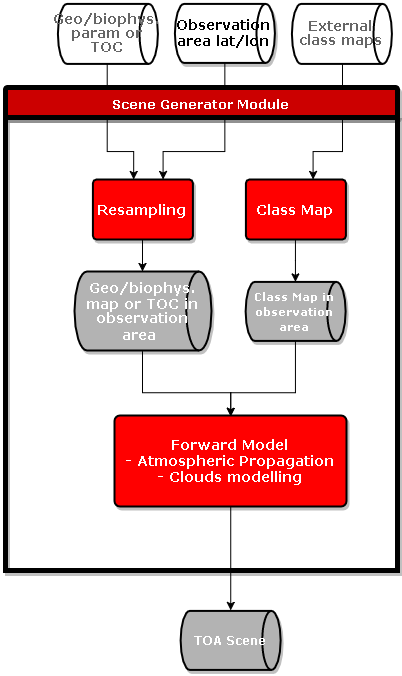Instruments
Passive Optical
Scene Generator
The Scene Generator Module is in charge of simulating the observed scene, the energy arriving to the instrument detector elements. The simulation chain of the Scene Generator Module starts from the geo/bio-physical variable that is the target of the mission (the soil moisture, the salinity of the oceans, the chlorophyll, etc.). The electromagnetic radiation has a different response depending on the terrain properties and the environment (atmosphere, clouds, etc.). To model this response a Radiative Transfer Model (RTM) is applied to the input geo/bio-physical map. The RTM calculates either the reflectance (the reflected energy at Top-Of-Canopy, the TOC image), or directly the Top-of-Atmosphere image (TOA), which includes the propagation of the electromagnetic radiation through the atmosphere. Clouds also have an impact on the propagation of the energy.
The composing Blocks of the Scene Generator are the following:
- The Resampling Block interpolates the input map in bio/geo-physical variable or TOC to the observation area.
- The Class Map Block classifies the landcover type of each pixel (vegetation, ocean, coastal area, urban area, etc.)
- The Forward Model Block calculates the reflectance or reflectivity, depending on the Radiative Transfer Model and the landcover type of each pixel. The Atmosphere and Clouds Simulator applies the atmospheric radiative transfer model to the reflectance (Top-of-Canopy image), in order to calculate the Top-of-Atmosphere image
The simulation flow of the Scene Generator Module is shown in the diagram below:
Biblos.COTS This is Biblos COTS package with installation script. Script installs libraries:- kissFFT- boost- netcdf- zlib- hdf5- eigen
Biblos.Resampling The Resampling Block interpolates the input external image to the Scene Generator Module to the observation are as calculated by the Geometry Module. The external input image to this Block is either an image in Top-of-Canopy (TOC) reflectances or an image in the biophysical parameter. The output of the Block is the same (TOC or bio/geophysical parameter), resampled to the lat/lon grid defined in the geometry AOCS/Instrument coupling Block matrix. Input image should have a finer resolution than the observation area grid with already applied sampling factor. For each detector element, the Instrument Projection algorithm projects the pixel array onto the imaging area. The energy received depends on the Instantaneous Field Of View (IFOV) and pixel dimensions. In BIBLOS a constant nominal pixel size is considered. There is no attenuation considered due to pixel size. In the following equation, size_pixel is considered equal to size_ref.
Biblos.Commons This is a package common for all the Blocks and Modules. Commons contain helper functions e.g. for reading NetCDF or parsing XML files as well as Blocks and Modules interfaces.
Multi-band Imager - Instrument data simulator, Proof of Concept Passive Optical Imager - Geometry, Scene Generator & Instrument Modules
Guide for LUT BIBLOS conducts atmosphere simulation calculations based on lookup tables. For that reason it is necessary to provide a set of most common used LUTs and an instructions how to use them. The package contains sheet with basic scenarios list and short guide how to use them.
Lookup tables (vulcan) for Atmosphere Simulator Block BIBLOS conducts atmosphere simulation calculations based on lookup tables. For that reason it is necessary to provide a set of most common used LUTs. The package includes subset of LUTs for parameters (names in brackets represents values that should be used in config files):
Atmosphere: u.s. standard (afglus)
Vulcan: high vulcanic (3)
Haze: rural (1)
Visibility: 10 km (10)
Precipitable water: 15 kg/m^2 (15)
Season: spring-summer (1) and fall-winter (2)
Lookup tables (urban) for Atmosphere Simulator Block BIBLOS conducts atmosphere simulation calculations based on lookup tables. For that reason it is necessary to provide a set of most common used LUTs. The package includes subset of LUTs for parameters (names in brackets represents values that should be used in config files):
Atmosphere: u.s. standard (afglus)
Vulcan: background (1)
Haze: urban (5)
Visibility: 20 km (20)
Precipitable water: 15 kg/m^2 (15)
Season: spring-summer (1) and fall-winter (2)
Lookup tables (ocean) for Atmosphere Simulator Block BIBLOS conducts atmosphere simulation calculations based on lookup tables. For that reason it is necessary to provide a set of most common used LUTs. The package includes subset of LUTs for parameters (names in brackets represents values that should be used in config files):
Atmosphere: u.s. standard (afglus)
Vulcan: background (1)
Haze: maritime (4)
Visibility: 20 km (20)
Precipitable water: 30 kg/m^2 (30)
Season: spring-summer (1) and fall-winter (2)
Lookup tables (vulcan 1, haze 1, visibility 100) for Atmosphere Simulator Block BIBLOS conducts atmosphere simulation calculations based on lookup tables. For that reason it is necessary to provide a set of most common used LUTs. The package includes subset of LUTs for parameters (names in brackets represents values that should be used in config files):
Atmosphere: u.s. standard (afglus)
Vulcan: background (1)
Haze: rural (1)
Visibility: 100 km (100)
Precipitable water: 15 kg/m^2 (15)
Season: spring-summer (1) and fall-winter (2)
Lookup tables (vulcan 1, haze 1, visibility 50) for Atmosphere Simulator Block BIBLOS conducts atmosphere simulation calculations based on lookup tables. For that reason it is necessary to provide a set of most common used LUTs. The package includes subset of LUTs for parameters (names in brackets represents values that should be used in config files):
Atmosphere: u.s. standard (afglus)
Vulcan: background (1)
Haze: rural (1)
Visibility: 50 km (50)
Precipitable water: 5 kg/m^2 (5), 15 kg/m^2 (15) and 30 kg/m^2 (30)
Season: spring-summer (1) and fall-winter (2)

